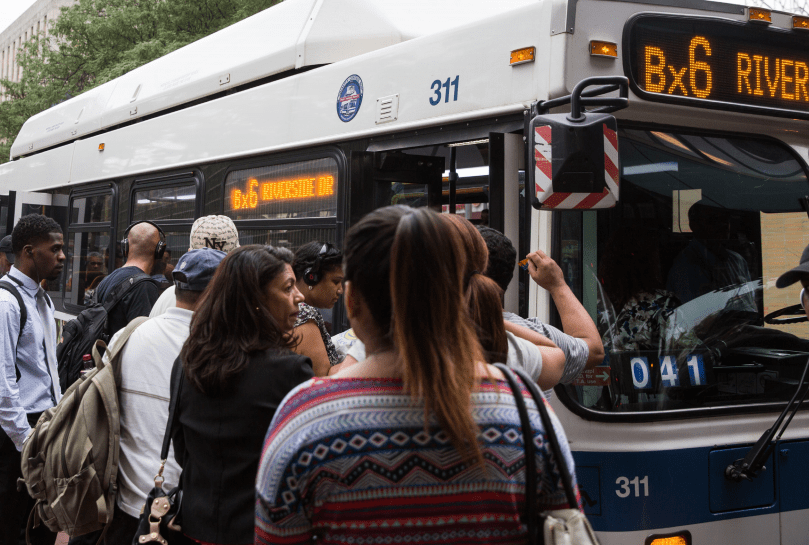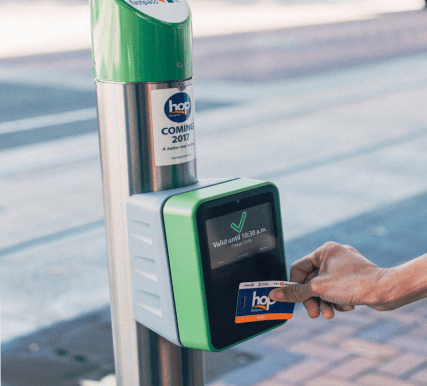Changing the way we pay for transit is about much more than carrying around a new type of farecard. Fare policy can speed up buses, expand trip options for riders, and lower barriers to transit access.
With the MTA contracting with Cubic to upgrade its fare payment system, the next few years should be a time of rapid change and improvement, with the agency adopting policies that make transit faster and more convenient for riders.
The key word is "should." Just because new fare technology will open up possibilities for the MTA to adapt best practices, doesn't mean those changes are inevitable. A generation ago, it took a sustained advocacy effort to get the MTA to maximize the utility of the MetroCard and allow unlimited passes and free transfers between subways and buses.
Today, with ridership falling and service deteriorating, it's inexcusable to delay the improvements the new fare system will unlock. In a new report, TransitCenter and the Tri-State Transportation Campaign lay out the opportunities inherent in a contactless fare payment system [PDF]. Here's a look at what they envision and the current state of play at the MTA.
Faster buses
The plodding process of paying bus fares one-by-one at the front door is a big reason why NYC bus service is the slowest in the nation. There's a better way: Cities like London and San Francisco took advantage of the features of modern farecards to implement citywide all-door boarding. With cashless transactions and all-door boarding on every bus, every bus route in New York would move faster overnight.
But there's a big red flag in the MTA's contract with Cubic, which only mentions "trials of on-board fare collection and all-door boarding" on Select Bus Service routes. This falls far short of what the objective should be. The vast majority of bus routes are not designated as SBS routes. And paying on-board on SBS routes would actually slow down service compared to the status quo, where SBS passengers pre-pay at the curb.
Advocates recommend a system where people validate their farecard at the curb on high-ridership bus routes. With contactless farecards, the curbside validation machines can be smaller and simpler than the ticket-vending machines currently in use on Select Bus Service routes. On low-ridership routes, on-board validators would still enable all-door boarding.
Better access to regional rail
LIRR and MetroNorth service runs through the Bronx, Queens, and Brooklyn, but commuter rail fares are effectively siloed from the subway and bus system most New Yorkers rely on. You can't use a regular MetroCard to buy a trip on the LIRR. So city residents are shut out from transit that ostensibly serves their neighborhoods, while seats on commuter trains sit empty. To be useful city transit and not just suburban commuter rail, LIRR and MetroNorth need to work seamlessly with the urban fare system.
With new fare technology, it's easier to integrate the different services so transferring from a bus to a commuter train is as easy as transferring from a bus to a subway. The MTA has said it intends to pilot a unified commuter rail/subway/bus fare at some LIRR stations, and advocates want a firm commitment to a permanent integrated fare system encompassing all commuter rail stops within city limits.
In the same vein, advocates are calling on the MTA to integrate its new fare media with other transportation services, enabling people to, for instance, pay for Citi Bike with their MTA account.
Fairer fares
In the current fare system, people who can afford the upfront cost of a monthly MetroCard pay less per ride than people who can only afford to buy one fare at a time. A fairer system would cap the monthly amount a rider spends at the price of an unlimited pass -- in effect, they could pay for an unlimited in installments.
It's not an idea the MTA has broached on its own, but cities including London and Portland have launched "fare-capping" policies, and advocates recommend the MTA do the same.
Fare capping? you ask. How to provide fare discounts fairly, not only to higher-income riders pic.twitter.com/8oq4gHSOkr
— TransitCenter (@TransitCenter) February 28, 2018
Advocates also call for the adoption of a "Fair Fares" policy to provide half-price fares for low-income New Yorkers. (As proposed by the Riders Alliance and the Community Service Society, this would be subsidized by the city as a social service.)
Both policies would have the added benefit of creating incentives to pay with farecards instead of cash, which can further improve bus speeds and reliability.







